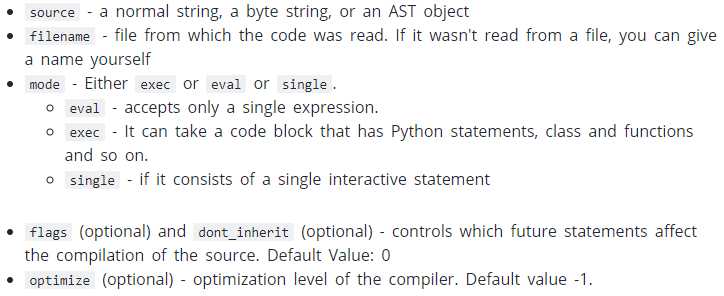标签:string character into not [] oat img array rac
abs(number) 絕對值
The abs() method takes a single argument:
num - number whose absolute value is to be returned. The number can be:
any(iterable)
The any() method returns True if any element of an iterable is True. If not, any() returns False.
*iterable(list, string, dictionary, tumple ...)
True if at least one element of an iterable is trueFalse if all elements are false or if an iterable is empty (表 "0", "False", empty
all(iterable)
The all() method returns True when all elements in the given iterable are true. If not, it returns False.
ascii(object) ascii編碼(拉丁字母)
The ascii() method returns a string containing a printable representation of an object. It escapes the non-ASCII characters in the string using \x, \u or \U escapes.
*object (like: strings, list etc).
bin(num) 轉二進制
The bin() method converts and returns the binary equivalent string of a given integer. If the parameter isn‘t an integer, it has to implement __index__() method to return an integer.
__index__() method to return an integernumber = 5 print(‘The binary equivalent of 5 is:‘, bin(number))
The binary equivalent of 5 is: 0b101
bool([value]) 轉布爾值
The bool() method converts a value to Boolean (True or False) using the standard truth testing procedure.
The following values are considered false in Python:
NoneFalse0, 0.0, 0j(), [], ‘‘.{}__bool__() or __len()__ method which returns 0 or False
bytearray([source[, encoding[, errors]]])
The bytearray() method returns a bytearray object which is a mutable (can be modified) sequence of integers in the range 0 <=x < 256.
If you want the immutable version, use bytes([source[, encoding[, errors]]]) method.
callable(object) object是否定義過
The callable() method returns True if the object passed appears callable. If not, it returns False.
chr(i) 回傳unicode的對應值
The chrt() method returns a character (a string) from an integer (represents unicode code point of the character).
compile(source, filename, mode, flags=0, dont_inherit=False, optimize=-1)
The compile() method returns a Python code object from the source (normal string, a byte string, or an AST object).
The code object returned by the compile() method can later be called using methods like: exec() and eval() which will execute dynamically generated Python code.

exec(object, globals, locals)
The exec() method executes the dynamically created program, which is either a string or a code object.
eval(expression, globals=None, locals=None)
The eval() method parses the expression passed to this method and runs python expression (code) within the program.

classmethod(function)
The classmethod() method returns a class method for the given function.
@classmethod 高端裝飾,接在 def Person.printAge()之前,效果同等 Person.printAge = classmethod(Person.printAge)
未完待續
https://www.programiz.com/python-programming/methods/built-in/classmethod
标签:string character into not [] oat img array rac
原文地址:https://www.cnblogs.com/pyleu1028/p/9886677.html